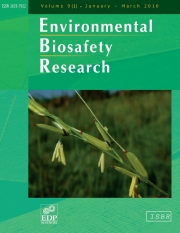Article contents
Environmental implications of gene flow from sugar beetto wild beet - current status and future research needs
Published online by Cambridge University Press: 15 June 2003
Abstract
Gene flow via seed or pollen is a basic biological process in plant evolution. The ecological and genetic consequences of gene flow depend on the amount and direction of gene flow as well as on the fitness of hybrids. The assessment of potential risks of transgenic plants should take into account the fact that conventional crops can often cross with wild plants. The precautionary approach in risk management of genetically modified plants (GMPs) may make it necessary to monitor significant wild and weed populations that might be affected by transgene escape. Gene flow is hard to control in wind-pollinated plants like beet (Beta vulgaris). In addition, wild beet populations potentially can undergo evolutionary changes which might expand their geographical distribution. Unintended products of cultivated beets pollinated by wild beets are weed beets that bolt and flower during their first year of planting. Weed beets cause yield losses and can delay harvest. Wild beets are important plant genetic resources and the preservation of wild beet diversity in Europe has been considered in biosafety research. We present here the methodology and research approaches that can be used for monitoring the geographical distribution and diversity of Beta populations. It has recently been shown that a century of gene flow from Beta vulgaris ssp. vulgaris has not altered the genetic diversity of wild Beta vulgaris L. ssp. maritima (L.) Arcang. in the Italian sugar beet seed production area. Future research should focus on the potential evolution of transgenic wild beet populations in comparison to these baseline data. Two monitoring models are presented describing how endpoints can be measured: (1) “Pre-post” crop commercialization against today's baseline and (2) “Parallel” to crop commercialization against GMP free reference areas/populations. Model 2 has the advantage of taking ongoing changes in genetic diversity and population dynamics into account. Model 1 is more applicable if gene flow is so strong that most areas/populations contain GMPs. Important traits that may change the ecology of populations are genes that confer tolerance to biotic and abiotic stress. An assessment of environmental effects can realistically only be based on endpoints and consequences of gene introgression, which may include economic values of biodiversity in littoral and other ecosystems containing wild beet. In general, there is still a great need to harmonize worldwide monitoring systems by the development of appropriate methods to evaluate the environmental impact of introgressed transgenes.
- Type
- Research Article
- Information
- Copyright
- © ISBR, EDP Sciences, 2003
References
- 32
- Cited by


